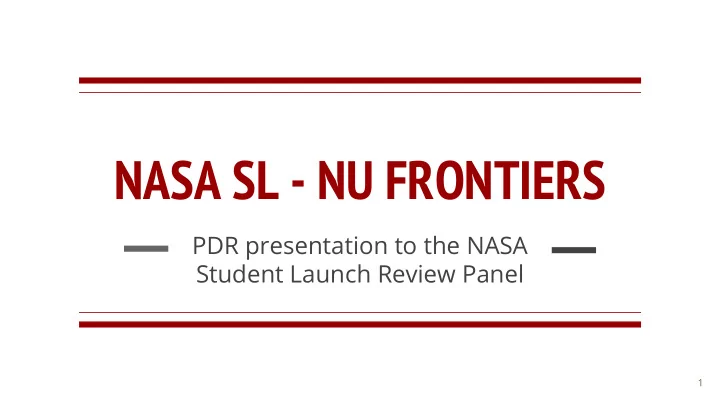

NASA SL - NU FRONTIERS PDR presentation to the NASA Student Launch Review Panel 1
Agenda Launch Vehicle Overview Requirement Compliance Plan ● ● Nose Cone Section STEM Outreach ● ● Payload Section Questions ● ● Lower Avionic Bay Section ● Booster Section ● Motor Selection ● Acent Analysis ● Launch Procedure and Separations ● Recovery System ● Payload Mechanical ● Payload Electronics ● Deployment Protocol ● 2
Launch Vehicle Overview Materials ● Airframe, Nosecone and Coupler - G12 Fiberglass (Madcow Rocketry) ○ Fins - G10 Fiberglass ○ Centering Rings and Bulkheads - Birch Plywood ○ Length - 149 inches ● Mass - 20.1 kg ● 3
Launch Vehicle Overview 4
Launch Vehicle Overview - Material Alternatives Fiberglass ● Pros: Strength, durability ○ Cons: Heavy, toxic ○ Carbon Fiber ● Pros: Strength, durability ○ Cons: Heavy, toxic, expensive ○ Blue Tube (Galvanized Cardboard) ● Pros: Light, cheap ○ Cons: Low strength, susceptible to environment ○ 5
Nose Cone Section: Dimensions and Materials Shape: 5:1 Ogive (~30 inches long) ● Materials: G12 Fiberglass ● Weight: 2.3 pounds ● 6
Nose Cone Section: Avionics Bay and Parachute Nose Cone Avionics Bay ● Two Perfectflite Stratologgers ○ One XBEE Pro XSC (S3) GPS Unit ○ Powered by 9V Duracell Batteries ○ At 800 feet, ignites separation charge and falls independently on 48 inch ● nylon parachute Attached with kevlar cord ○ ¼”-20 eyebolt mount ○ 7
Payload Section 8
Payload Section - Dimensions 9
Lowe Avionics Bay Section Contains ● Lower Avionics Bay ○ Drogue Parachute ○ Lower Sections Main Parachute ○ 10
Lowe Avionics Bay Section - Dimensions 11
Booster Section Includes ● Motor ○ Fins ○ 12
Booster Section- Dimensions 13
Motor Selection - L1395-BS Projected Apogee: 5,370 feet ● Total Impulse: 4,874.96 N-s ● Thrust to Weight: 7.08 ● 14
Motor Selection - Alternatives Motor Burn Time Max Apogee Total Impulse Mass with Mass without (s) Acceleration (ft) (N*s) Fuel (g) Fuel (g) (Gs) L1395-B 3.34 7.69 5370 4895 4323 1848 S-P L2375- 2.07 12.2 5446 4905 4161 1840 WT-P L1115-P 4.47 7.32 5519 5017 4404 2010 L1350-C 6.95 3.17 4655 4280 3571 1546 S 15
Ascent Analysis CP: 112 inches from tip of nose cone Exit velocity off 144 inch Rail: 74 feet/s CG: 93.816 inches from tip of nose cone Thrust to Weight (L1396-BS Motor): 7.08 16
Launch Procedure and Separations 17
Recovery System - Avionics Bays Nose Cone Avionics Bay ● 3D Printed ABS Fixture ○ Deploys 48” Main Nose Cone Section Nylon Parachute at 800 feet ○ Two Perfectflite Stratologger Altimeters ○ One XBEE Pro XSC (S3) GPS Unit ○ Powered by 9 Volt Duracell Batteries ○ 18
Recovery System - Parachutes A(in 2 ) Parachute C D Manufacturer 48” Nylon Parachute 0.8 1564.4 Sunward Group Ltd 72” Iris Ultra Light 2.2 6840 Fruity Chutes Parachute Fruity Chutes Iris Ultra Light Parachute 19
Recovery System - Kinetic Energy 75 ft-lb Maximum Competition Requirement Section Mass Total (lb) Parachute Data (CD * Kinetic Energy (ft * lb) A) Nose-Cone 5.63 Nose Cone Main 26.299 Main Avionics Bay 5.29 Drogue + Booster 50.644 Main Booster Section 8.01 Drogue + Booster 74.911 Main Payload 12.8 Drogue + Booster 76.23 Main 20
Recovery System - Lateral Drift 2,500 foot Lateral Drift Maximum Competition Requirement Launch Vehicle Drift Calculations Using OpenRocket Simulation Software, 10 Simulation Average Wind Speed Nose Cone Section Payload/ Lower Avionics/ Booster Sections No Wind 8 feet 8 feet 5-mph 523 feet 486 feet 10-mph 1,137 feet 1,067 feet 15-mph 1,782 feet 1,660 feet 20-mph 2,575 feet 2,421 feet 21
Payload Mechanics Self-righting design ● 6” Pneumatic tires ● Solar panel fan ● Opened by servo motor ○ Deployable counter-torque ● Actuated by servo motor ○ 3D printed body ● 22
Payload Electronics Arduino Sensor Suite ● Accelerometer ○ Upright detection ■ GPS ○ Rover location ■ XBEE Telemetry ● Ground station signal ○ Motor Control ● Lithium Ion Battery ● 23
Full Scale Payload Electronics 24
Deployment Protocol ● Launch Vehicle returns to ground ● Ground station relays command XBEE -> XBEE ● Rover deploys from launch vehicle in capsule ● Spring loaded capsule opens and deploys rover ● Rover accomplishes task ● GPS module will relay rover position back to the ground station via XBEE radio device 25
Payload Design Process The team utilized the following decision matrix to choose a rover design path to pursue Goal Tank Treaded Rover 4-Wheeled Rover 2-Wheeled Rover Achievability 15% 20% 15% Obstacle Avoidance 12% 3% 3% Size 9% 12% 27% Durability 20% 16% 30% Total 56% 51% 75% 26
Requirement Compliance Plan Project Lead Safety Officer Launch Vehicle Payload Mechanical Payload Electrical Technical Lead Technical Lead Technical Lead 27
STEM Outreach 28
Questions 29
Recommend
More recommend